In the race to offer a fully personalized customer experience (CX), life sciences leaders are looking at new technologies to drastically improve healthcare professionals (HCP) and patient journeys which have long suffered from the industry’s technology lag. The goal is to adopt the frictionless and modern experience recognized by other CX-focused industries.
While 50% of life sciences professionals say that their organization’s investment is going toward new technology to improve customer experiences, as PwC has remarked, “Companies won’t be able to solve their CX problems with technology alone.”1,2 To overcome data silos and disconnected messaging across channels, life sciences companies need to adopt a customer experience management (CXM) strategy – which “may be the single most important investment a brand can make” according to Forbes – and combine it with a technology stack that supports a customer-first approach.3 Companies that adopt a CXM platform will benefit from a unified data model, omnichannel capabilities, and a 360° view of customer insights enabling the adopters to come out on top in a post-COVID landscape.
If you are a Chief Digital Officer (CDO), Chief Information Officer (CIO), Marketing Director, or Commercial or Medical Affairs leader interested in understanding the challenges as well as the opportunities in closing this gap to elevate customer and patient experiences, this publication is for you.
Life Sciences Organizations Need to Reimagine Their Customer Management Strategy
Despite the urgent need to adapt to the change in HCP and patient expectations through digital investments, not all investments in technology are considered successful. In fact, more than 4 out of 10 senior leaders across industries believe that the impact of their business’ digital transformation has been limited.4 When those projects were considered successful, 72% of organizations ran into new obstacles that could affect their future growth.5 Life sciences organizations fared no better. Although many are pushing toward digital advancements, the gap between customer expectations and satisfaction with the experiences they receive is still large and reported as 25% in the healthcare sector and 22% in pharma.2
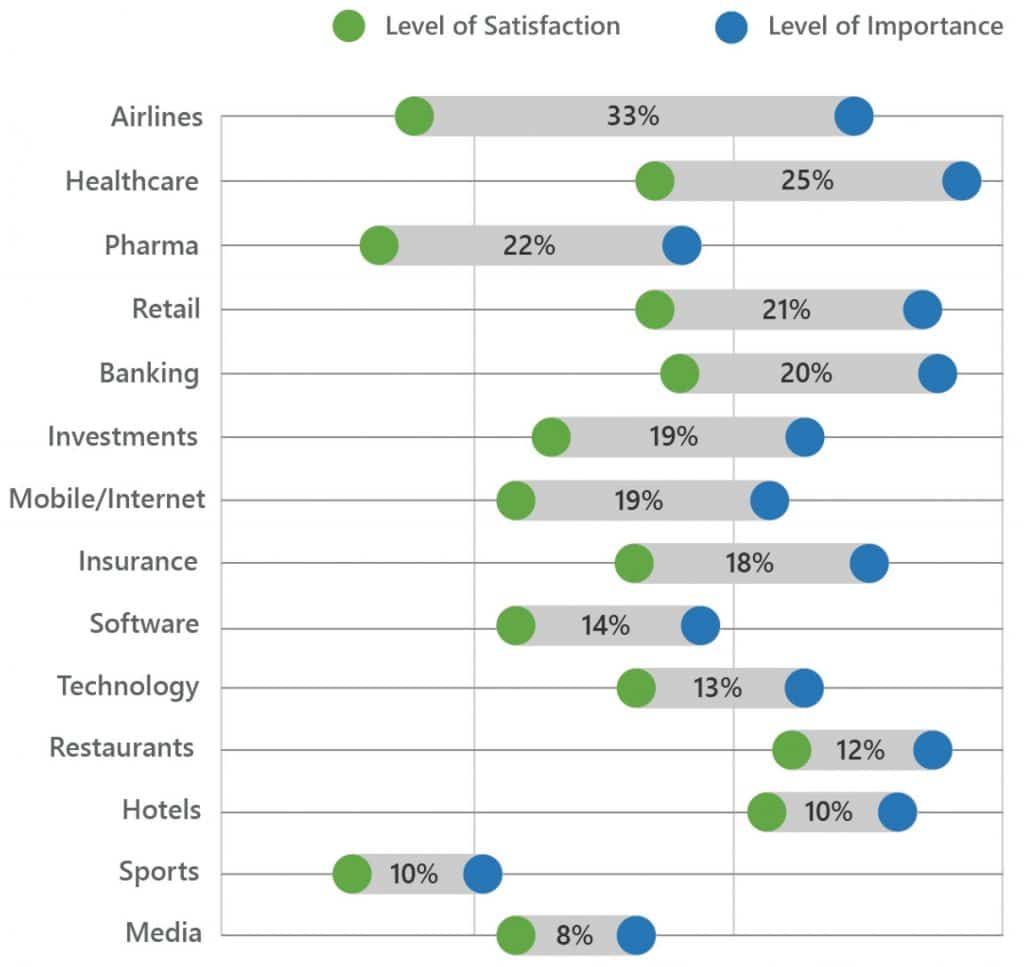
Q: When it comes to making purchase decisions, how important is customer experience in each of the following industries? Generally speaking, how would you rate the customer experience in each of the following industries today?
Source: PwC Future of Customer Experience Survey 2017/18
Although a digital transformation project can play a part in elevating the CX, a cautionary tale emerges. The lesson for life sciences organizations is that merely implementing a multitude of transactional technologies such as customer relationship management (CRM), virtual meeting tools, marketing automation system, and other such technologies individually in the name of customer centricity may not be enough. Although each of these spends may enable a particular set of transactions with customers, they may not empower employees to make the overall experience they provide to be more seamless, intelligent, and meaningful.
All About CX
The impact a CX strategy can have on an organization’s bottom line is well known from extensive studies. Most industries are witnessing a binary shift, from a brand-centric transactional focus to a customer-centric experiential approach. According to Forbes, the number of organizations competing on CX has nearly doubled.6 Think of class leaders such as Amazon, Tesla, Ikea, and Mastercard who are all benefiting fiscally from delivering a satisfactory CX end to end. In fact, companies with superior customer experiences bring in 5.7 times more revenue than competitors who are lagging in this area.6
With 84% of firms aspiring to be CX leaders, Gartner named CX the “New Competitive Battlefield”.7,8 A recent report states that companies delivering superior CX:
- Grew revenues 5 times faster than their competitors with inferior CX9
- Have customers willing to pay a higher price for products and services6
The impact of a CX-oriented strategy is clear in life sciences. McKinsey & Company surveyed 600 physicians and found that prescribers satisfied with their customer journey were twice as likely to prescribe a medication than their dissatisfied peers.10
Average likelihood to prescribe vs satisfaction with customer experience, %
(n = ~600 prescribing immunologists in France, Germany, UK, and US)*
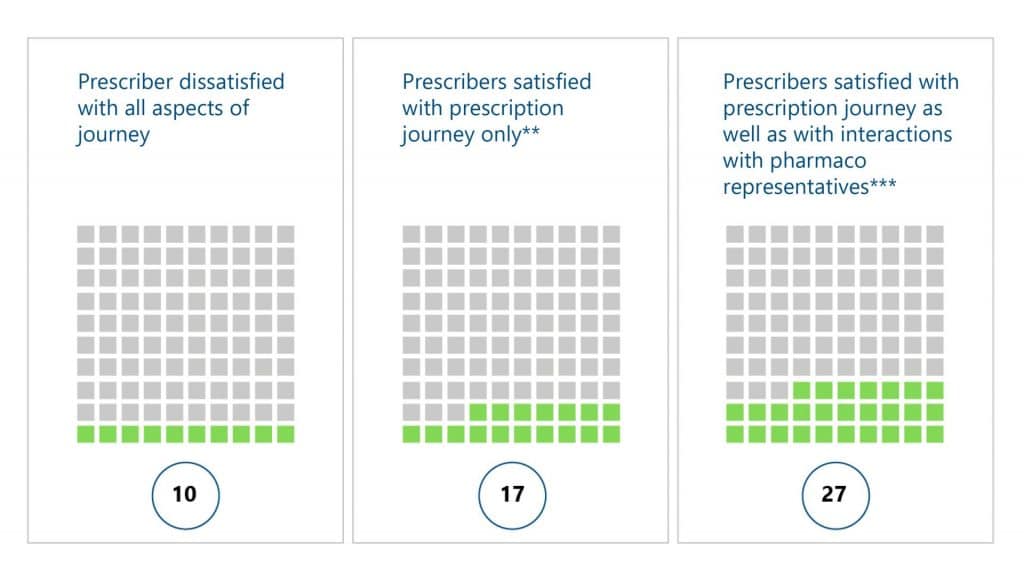
**Interactions with patents from diagnosis and prescription to monitoring and follow-up.
***Including approach to acquiring and developing medical and scientific knowledge.
Not only that, but better CX is also needed for life sciences organizations to deliver important information and communications about their products to healthcare practitioners because it leads to:
- Increased number of engagements
- Improved opinion and understanding of the products
- Increased willingness to digitally engage11
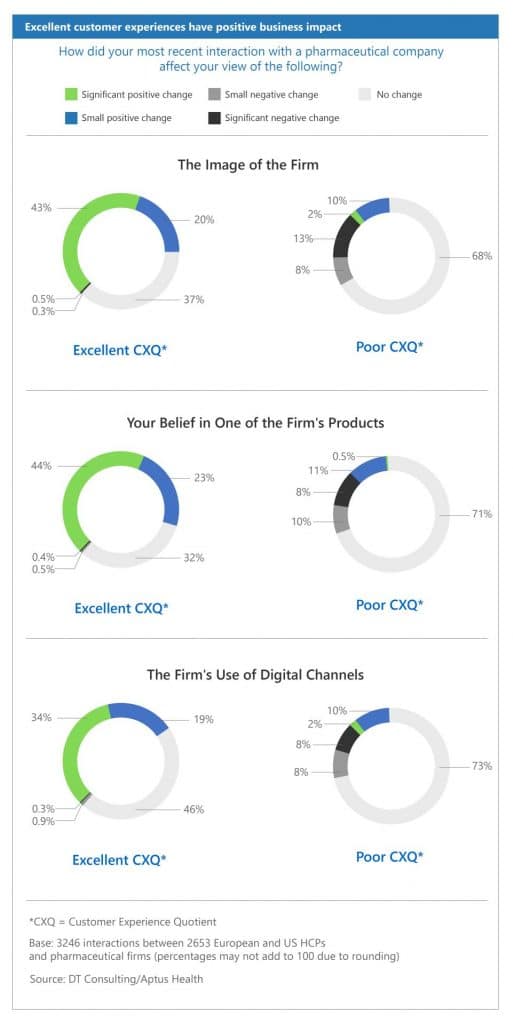
The effects of better CX extend to the patient community as well. According to a recent survey by Accenture, 76% of patients believe that research-based organizations have a responsibility to provide services that complement their products and as a result, 85% of the organizations are raising their investment in patient-centric capabilities.12 What this means is that delivering better CX to practitioners and patients can enable life sciences organizations in their core mission of creating better health outcomes. This is because in addition to being a research machine, every life sciences organization is also a communications and information machine that must be able to provide the right information, at the right time, in the right way to the intended patients and practitioners so that they may correctly use the products they bring to market.
Source: Omnipresence
Pillars of Modern CXM Technology
Gartner defines CXM as “the practice of designing and reacting to customer interactions to meet or exceed their expectations, leading to greater customer satisfaction, loyalty, and advocacy.”13 CXM-driven strategies and solutions go well beyond the typical personal and non-personal transactions that are still the norm in life sciences. Commonly faced realities in at least 5 key areas reveal more about the challenges with the prevalent transactional approaches.
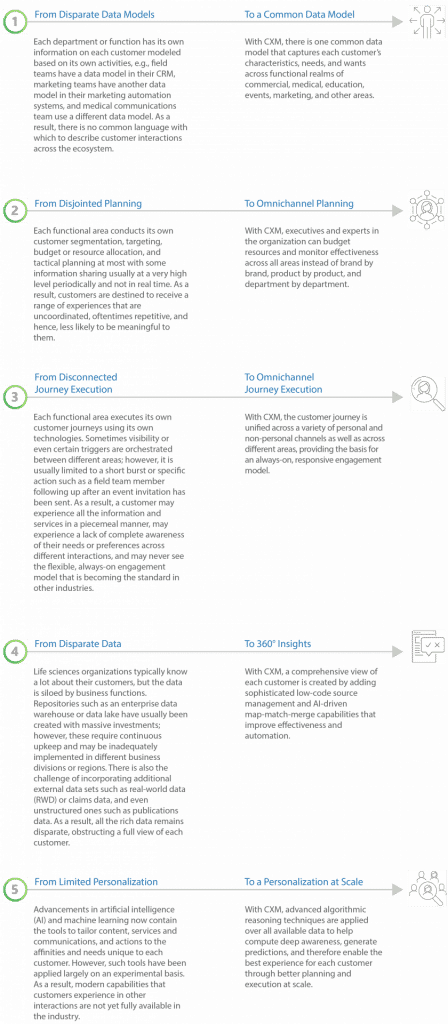
By recognizing and overcoming challenges in these 5 areas, life sciences organizations could narrow the gap between customer expectations that are evolving beyond transactional interactions and a meaningful CX. Incorporating these pillars into legacy application stacks, platforms, and organization designs is, however, a difficult struggle.14 The obstacles that would be faced include data silos between functional areas, coordinating customer interactions and satisfaction across multiple business processes, lack of real-time planning across brands and product lines, and post facto understanding of customer behaviors with unscaled advanced techniques such as machine learning or AI.15 There is also a technological challenge in legacy applications like the CRM and multichannel marketing (MCM) systems. The underlying architecture, the method of implementation, adoption process, and licensing formats can interfere with a CXM strategy.
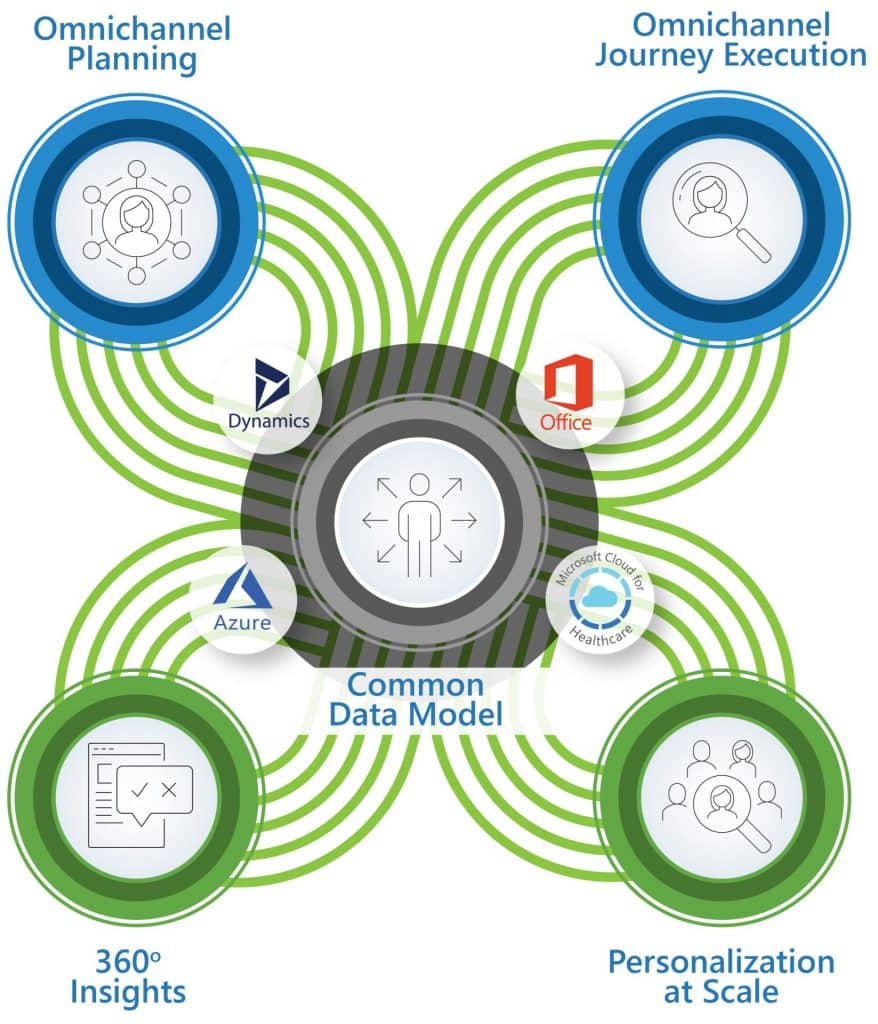
A recent Reuters survey reported that 75% of respondents need a more agile method of ingesting data and consolidating data to derive insights across channels and that around 30% of organizations are considering changing their CRM.1 Given the instrumental role a CXM strategy can have in elevating the customer experiences delivered by life sciences organizations, appropriate mitigation of these challenges is essential during technology evaluation.
Evolution of Tech Stack Maturity
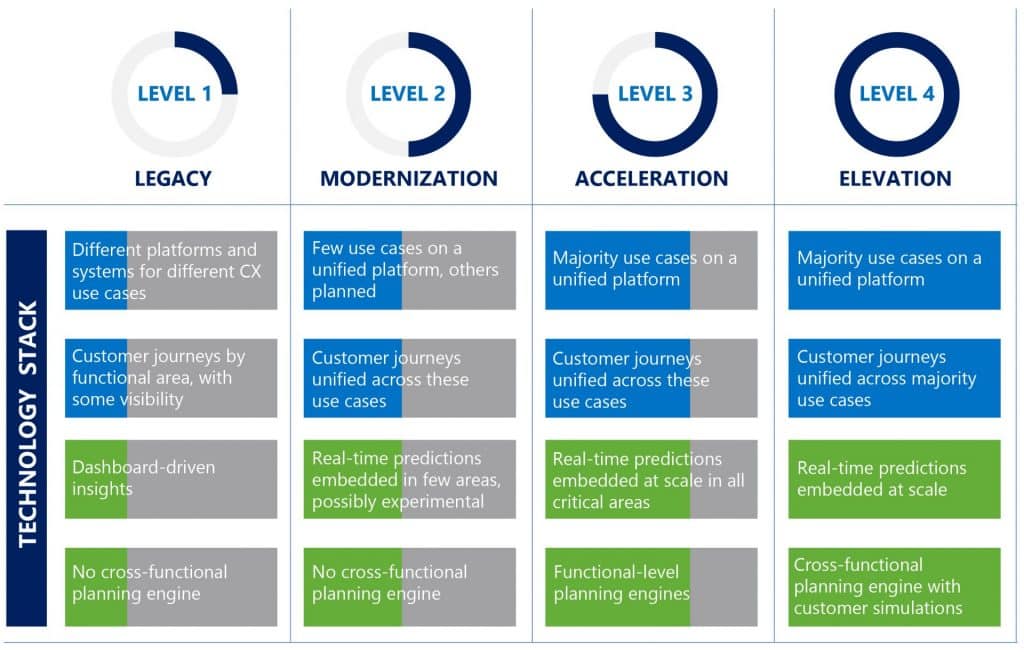
Overcoming CXM Challenges
Life sciences leaders have already expressed a sense of urgency around adopting CXM strategies.15 This urgency is intensified by the immediate and long-term business challenges as well as by the possible societal changes necessary to respond to the COVID-19 pandemic. Yet the main hurdle to adopting CXM strategies is not technology related. Before implementing new technologies, organizations must look at their current culture stack level to identify the progress needed to be made and possible hurdles to overcome.
Evolution of Cultural Stack Maturity
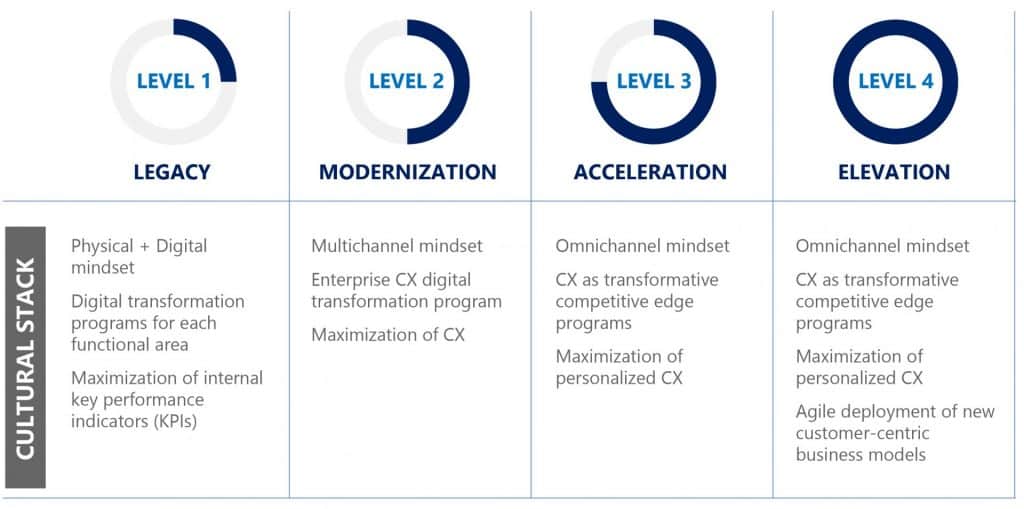
According to PwC, challenges to overcome fall into the following 3 categories:
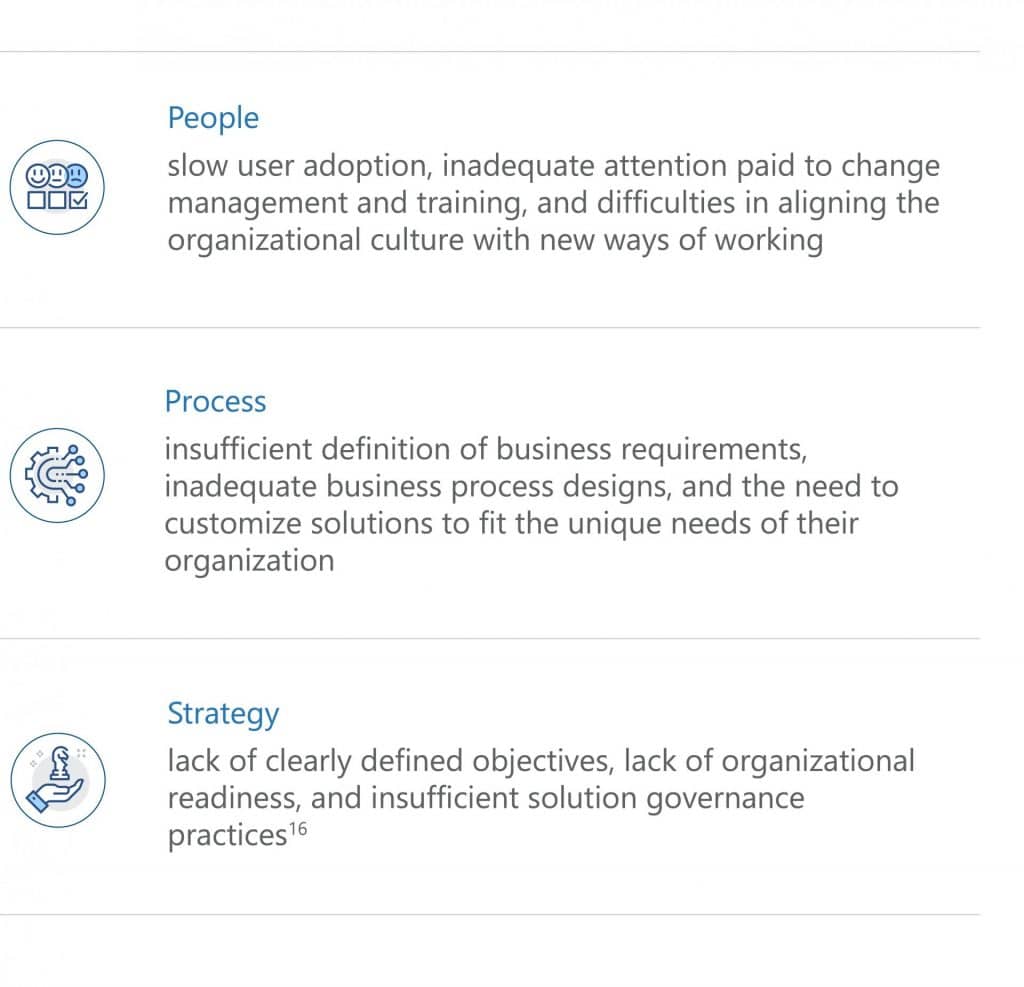
Given the instrumental role a CXM strategy can have in elevating the customer experiences delivered by life sciences organizations, appropriate mitigation of these challenges is essential during technology evaluation.
Overcoming People Challenges
According to Gartner, leading organizations with successful initiatives begin with establishing the correct vision and strategy for the entire organization.17 This means that the successful implementation of a CXM strategy starts at the top. This culture stack includes an appropriate change management plan cascading across all functional areas.
To ensure a successful transition, and adequate employee buy-in to the new strategy, organizations must follow the 8 key elements of change management:
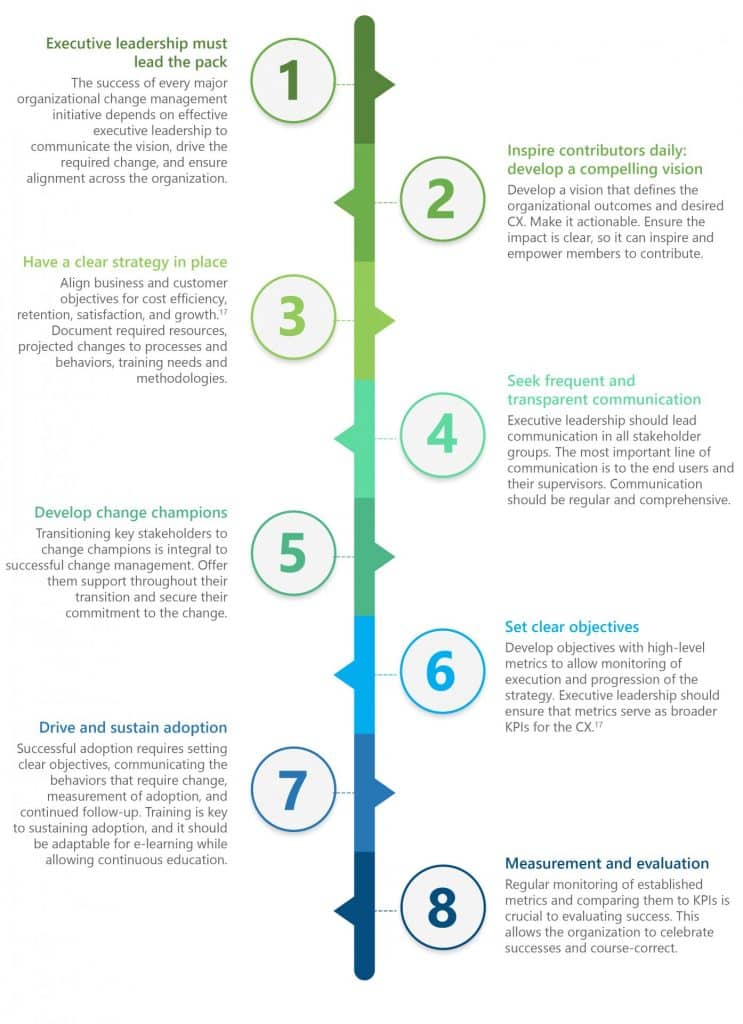
Overcoming Process Challenges
Immature business processes are a leading factor in the failure of a new strategy. Without a process improvement in place, the program may wane.18 Define and design end-to-end processes to mitigate risk across the enterprise. This includes novel processes for commercial teams, marketing teams, medical affairs, and education. This will reduce the friction during implementation, eliminate unnecessary steps, and improve employee adoption rates and outcomes.
Overcoming Strategy Challenges
CXM is not only a technology transformation program. It is also a cultural change for the organization, healthcare practitioners, stakeholders, and patients. An agile approach to strategy could accelerate time-to-value and bring a systematic execution, achieving predictable step-by-step results.
Once a thorough assessment of both the culture and tech stack has been completed, then a clear strategy can be developed and implemented to successfully adopt a CXM strategy and gain an experiential edge over competitors.
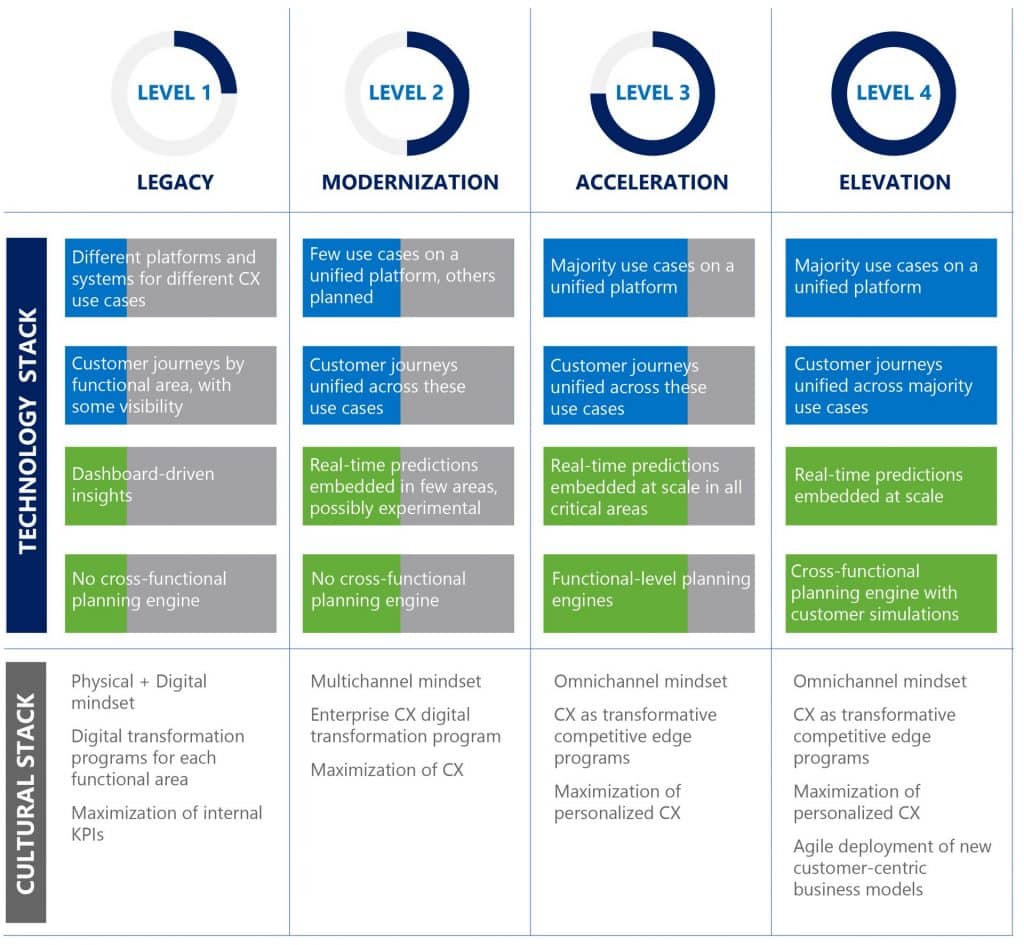
Source: Omnipresence
The COVID-19 Catalyzer Effect
In a few short months, the pandemic has affected global economies and virtually all industries. Since the outbreaks have occurred at such a rapid pace, life sciences organizations must now look forward to medium- and long-term repercussions and prepare accordingly, hence the importance of adopting a CXM strategy sooner rather than later.19
According to Gartner, CIOs and CDOs “should keep a running tab on COVID-19-related issues that will impact their businesses” and should link early warning signals to potential business impacts. Some of these early disruptions include:
- Massive and prolonged reduction in face-to-face physician engagement opportunities, which might impact prescriber and institutional engagement. It could also lead to an accelerated shift to digital and virtual interaction approaches19
- Fewer in-person meetings and face-to-face collaborations within the organization. This can lead to less unified messaging as most organizations lack the capability for real-time internal collaboration. This would lead to confusion among all stakeholders including customers, suppliers, and employees19
- Public sentiment and brand image can be positively or negatively affected depending on the nature and extent of communications, while the reaction time for course corrections is decreased19
Considering such significant, fundamental shifts, CIOs, and CDOs ought not to assess only the internal organizational needs and “inside-out” transformations. They must also look at the picture from the “outside-in” and possibly use this moment of rapid changes to reinvent the CX technology stack as well as cultural stack for their organizations in more fundamental ways. Asking these critical questions and getting the teams to find the answers that can best manage business and customer priorities during the pandemic as the next normal takes shape may be the key to driving experiential relationships as a competitive edge compared to organizations that remain stuck in the transactional plane.19
References
- Reuters. COVID-19: Accelerating digital transformation in life sciences. August 2020. Accessed September 24, 2020.
- Clarke D, Kinghorn R. Consumer intelligence series customer experience. PwC. 2018. Accessed May 4, 2020.
- Hyken S. Customer experience is the new brand. Forbes, July 15, 2018. Accessed May 5, 2020.
- McKendrick J. Plenty of digital transformation, but not enough strategy. Forbes. March 23, 2019. Accessed May 5, 2020.
- Saks D. Council post: Your digital transformation wasn’t enough. Now what? Forbes. August 9, 2019. Accessed May 5, 2020.
- Morgan B. 50 stats that prove the value of customer experience. Forbes. September 24, 2019. Accessed May 4, 2020.
- Thompson, B. Forrester: good and bad news on CX day. CustomerThink. October 12, 2016. Accessed May 4, 2020.
- Sorofman J, Thompson E. Customer experience is the new competitive battlefield. Gartner Research. June 4, 2015. Accessed May 3, 2020.
- Park AJ. Everybody benefits: the ROI of improved CX from Forrester’s “How customer experience drives business growth, 2018” report. Airship. August 7, 2019. Accessed May 3, 2020.
- Ascher J, Höglund D, M’lika A, et al. From product to customer experience: the new way to launch in pharma. McKinsey & Company. August 15, 2018. Accessed May 4, 2020.
- Van Tongeren T. The state of customer experience in the pharmaceutical industry, 2018: HCP interactions. DT Consulting, Aptus Health. April 2, 2019. Accessed May 7, 2020.
- Patel K. and Wiedenhörf E. Better together: why pharma companies and patient organizations need to collaborate differently to deliver better patient experiences. Accenture. 2019. Accessed May 7, 2020.
- Gartner Inc. Customer experience management. Gartner Glossary. Accessed May 5, 2020.
- Lopez M. From hand sanitizers to tacos: Microsoft shows us how companies are using technology to thrive during a pandemic. Forbes. May 14, 2020. Accessed May 5, 2020.
- Gandhi A. 4 foundational best practices for success in life science omnichannel marketing. Gartner Inc. February 19, 2020. Accessed March 30, 2020.
- Diamond M. The secrets to CRM success. Digital Pulse. June 20, 2018. Accessed May 7, 2020.
- Thompson E. The eight building blocks of CRM: overview. Gartner. May 16, 2019. Accessed May 7, 2020.
- Schaeffer C. The top reasons CRM fails. CustomerThink. February 13, 2017. Accessed May 4, 2020.
- Shanler M, Meyer S, Stevens A, Gandhi A, Smith J. Life science CIO action plan for COVID-19. Gartner. April 8, 2020. Accessed May 7, 2020.
